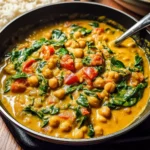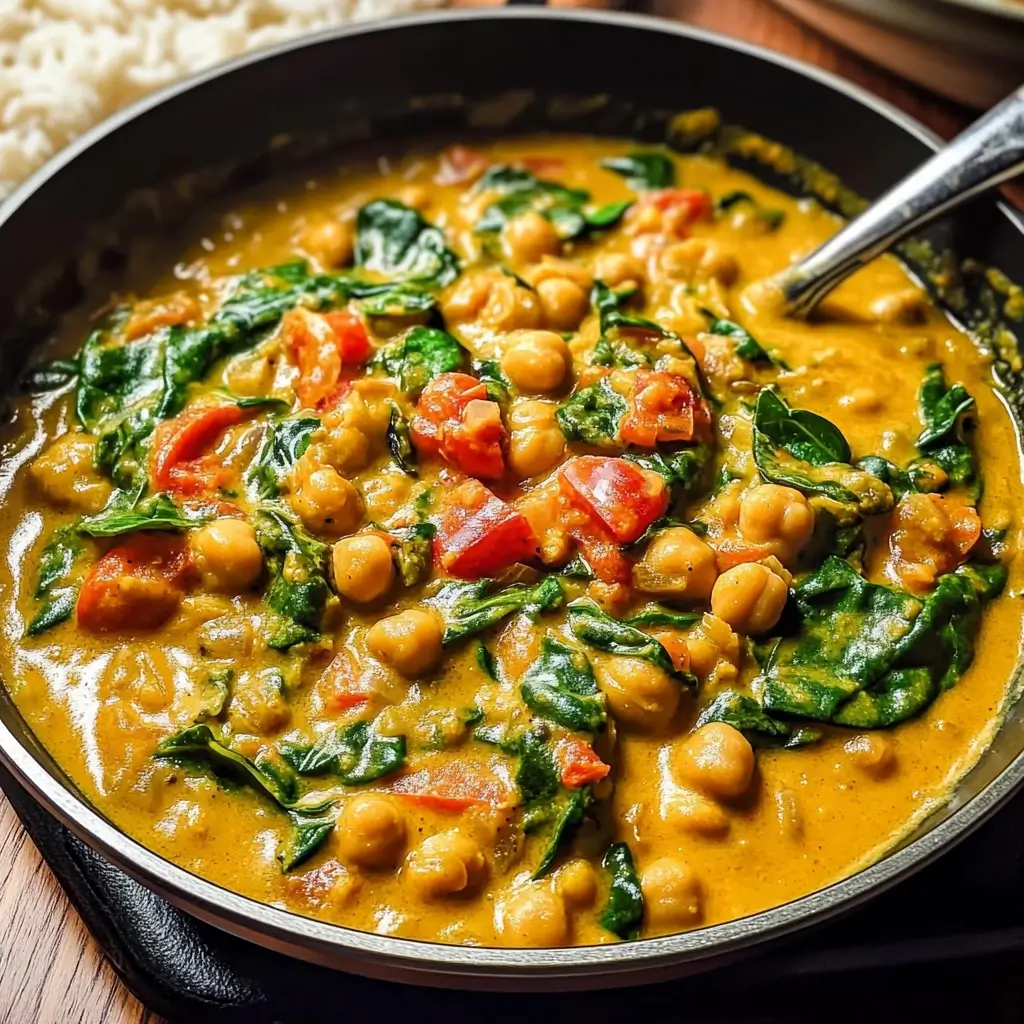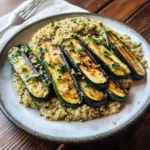There are some recipes that just become instant family favorites, and this Chickpea & Spinach Coconut Curry is definitely one of them in our home. From the moment the aromatic spices start to sizzle in the pan, filling the kitchen with an inviting warmth, you know you’re in for a treat. Even my picky eaters, who sometimes turn their noses up at anything green, devour this dish with gusto. The creamy coconut milk beautifully balances the earthy chickpeas and vibrant spinach, creating a symphony of flavors and textures that is both comforting and exciting. It’s become our go-to meal when we crave something healthy, flavorful, and satisfying without spending hours in the kitchen. Whether you are a seasoned curry enthusiast or a complete beginner, this recipe is incredibly easy to follow and promises a delicious, restaurant-quality meal right in your own home. Get ready to embark on a culinary journey that will tantalize your taste buds and leave you wanting more!
Ingredients
- Chickpeas (2 cans, 15 oz each): The heart of our curry, providing a hearty and protein-rich base. Canned chickpeas are convenient and readily available, making this recipe quick and easy.
- Spinach (10 oz bag fresh or frozen): Packed with nutrients and adds a beautiful green hue to the curry. Fresh or frozen spinach works equally well; if using frozen, ensure it is thawed and excess water is squeezed out.
- Coconut Milk (1 can, 13.5 oz full-fat): The secret to the creamy and luxurious texture of the curry. Full-fat coconut milk is recommended for the richest flavor, but light coconut milk can be used for a lower-fat option.
- Onion (1 medium, chopped): Forms the aromatic base of the curry, adding depth and sweetness as it caramelizes.
- Garlic (3-4 cloves, minced): Another essential aromatic, garlic brings a pungent and savory flavor that complements the spices beautifully.
- Ginger (1 inch piece, grated or minced): Adds a warm, zesty, and slightly spicy note, crucial for authentic curry flavor. Fresh ginger is best, but ginger paste can be used as a substitute.
- Tomato Paste (2 tablespoons): Concentrated tomato flavor that adds richness, umami, and a slight tang to the curry.
- Diced Tomatoes (1 can, 14.5 oz): Provides acidity and body to the sauce. Fire-roasted diced tomatoes can add an extra layer of smoky flavor.
- Vegetable Broth (1 cup): Adds moisture and enhances the overall flavor of the curry. Low-sodium vegetable broth is recommended to control the salt level.
- Olive Oil or Coconut Oil (2 tablespoons): Used for sautéing the aromatics and spices. Coconut oil enhances the coconut flavor profile, while olive oil is a neutral alternative.
- Curry Powder (2 tablespoons): A blend of spices that forms the foundation of the curry flavor. Adjust the amount to your spice preference.
- Turmeric Powder (1 teaspoon): Adds a warm, earthy flavor and vibrant yellow color, also known for its anti-inflammatory properties.
- Cumin Powder (1 teaspoon): Provides a warm, earthy, and slightly smoky flavor, adding depth to the spice blend.
- Coriander Powder (1 teaspoon): Offers a citrusy and slightly sweet note that balances the other spices.
- Garam Masala (1 teaspoon): A warm and fragrant spice blend added at the end to enhance the overall aroma and flavor.
- Red Pepper Flakes (½ teaspoon or to taste, optional): Adds a touch of heat for those who prefer a spicier curry.
- Salt and Pepper (to taste): Essential seasonings to balance and enhance all the flavors.
- Fresh Cilantro (for garnish, optional): Adds a fresh, herbaceous finish and vibrant green color.
- Lime wedges (for serving, optional): A squeeze of lime juice brightens the flavors and adds a zesty touch.
Instructions
- Prepare the Aromatics: Begin by chopping the onion and mincing the garlic and ginger. Having these aromatics ready beforehand will streamline the cooking process. Finely dicing the onion ensures it cooks down evenly and releases its sweetness into the curry base. Mincing the garlic and ginger maximizes their flavor impact.
- Sauté the Aromatics: Heat olive oil or coconut oil in a large pot or Dutch oven over medium heat. Once the oil is shimmering, add the chopped onion and sauté for 5-7 minutes, or until softened and translucent. Stir occasionally to prevent burning. Sautéing the onion first allows it to become sweet and fragrant, forming the foundation of the curry’s flavor profile.
- Bloom the Spices: Add the minced garlic and ginger to the pot and sauté for another minute until fragrant. Be careful not to burn the garlic, as it can become bitter. Next, add the curry powder, turmeric powder, cumin powder, coriander powder, and red pepper flakes (if using). Cook for 1-2 minutes, stirring constantly, until the spices become fragrant and toasted. This step, known as “blooming” the spices, releases their essential oils and enhances their flavor, creating a more complex and aromatic curry.
- Build the Curry Base: Stir in the tomato paste and cook for 1 minute, allowing it to caramelize slightly and deepen the flavor. Then, add the diced tomatoes (undrained) and vegetable broth. Bring the mixture to a simmer, stirring occasionally. The tomato paste adds richness and umami, while the diced tomatoes provide acidity and body. The vegetable broth creates the liquid base of the curry, allowing all the flavors to meld together.
- Add Chickpeas and Coconut Milk: Drain and rinse the canned chickpeas and add them to the pot. Rinsing removes excess sodium and canning liquid. Pour in the full-fat coconut milk and stir well to combine. Coconut milk is what gives the curry its signature creamy texture and rich flavor, balancing the spices and acidity.
- Simmer and Thicken: Reduce the heat to low, cover the pot, and let the curry simmer for 15-20 minutes, or until the flavors have melded together and the curry has slightly thickened. Simmering allows the spices to fully infuse the sauce and the chickpeas to soften further, creating a cohesive and flavorful dish.
- Incorporate Spinach: Stir in the spinach, either fresh or thawed frozen. If using fresh spinach, add it in handfuls, allowing each batch to wilt before adding more. If using frozen spinach, ensure it is thawed and squeezed dry to remove excess water. Cook until the spinach is wilted and bright green, about 2-3 minutes. Spinach adds a boost of nutrients and a vibrant color to the curry.
- Season and Finish: Season the curry with salt and pepper to taste. Stir in the garam masala for a final layer of warm and aromatic spice. Taste and adjust seasonings as needed. Garam masala is typically added at the end of cooking to preserve its delicate aroma.
- Serve and Garnish: Serve the Chickpea & Spinach Coconut Curry hot over rice, quinoa, or naan bread. Garnish with fresh cilantro and a squeeze of lime juice, if desired. These garnishes add freshness and brightness to the finished dish.
Nutrition Facts (per serving, approximate)
- Serving Size: 1.5 cups (This recipe typically yields about 6 servings) – A generous and satisfying portion size, perfect for a main meal.
- Calories: 350-400 – A moderately calorie-dense meal, providing sustained energy and satiety.
- Protein: 15g – A good source of plant-based protein from chickpeas and spinach, essential for muscle building and repair. Protein contributes to feeling full and satisfied after eating.
- Fiber: 10g – High in dietary fiber from chickpeas, spinach, and vegetables, promoting digestive health and regularity. Fiber also helps regulate blood sugar levels and contributes to satiety.
- Iron: 20% DV (Daily Value) – A significant source of iron, particularly important for vegetarians and vegans, crucial for energy production and oxygen transport in the body.
Note: Nutritional values are estimates and may vary based on specific ingredients and portion sizes.
Preparation Time
- Prep Time: 15 minutes – This includes chopping vegetables, mincing aromatics, and gathering ingredients, making it a quick and efficient recipe to prepare.
- Cook Time: 30 minutes – From sautéing aromatics to simmering the curry and wilting spinach, the cooking process is relatively short, perfect for a weeknight meal.
- Total Time: 45 minutes – In under an hour, you can have a flavorful and healthy homemade curry ready to enjoy, making it an ideal option for busy individuals and families.
How to Serve
- With Rice: Basmati rice, brown rice, or jasmine rice are all excellent choices to soak up the flavorful curry sauce. Rice provides a neutral base that complements the richness of the curry.
- With Quinoa: For a higher protein and fiber option, serve the curry over cooked quinoa. Quinoa adds a nutty flavor and slightly chewy texture.
- With Naan Bread: Warm naan bread is perfect for scooping up the curry and enjoying every last bit of the delicious sauce. Garlic naan or plain naan are both great choices.
- With Roti or Chapati: These Indian flatbreads are another traditional pairing, offering a slightly healthier and whole-wheat alternative to naan.
- As a Soup: For a lighter meal, enjoy the curry on its own as a hearty and flavorful soup. You can add a dollop of plain yogurt or coconut cream for extra richness.
- Alongside Roasted Vegetables: Serve the curry with a side of roasted vegetables like cauliflower, broccoli, or sweet potatoes for a more substantial and balanced meal.
- With a Salad: A simple green salad or a cucumber and tomato salad can provide a refreshing contrast to the warm and rich curry.
- Garnishes: Fresh cilantro, a squeeze of lime juice, a sprinkle of red pepper flakes, or a dollop of yogurt or coconut cream can enhance the presentation and flavor of the curry.
Additional Tips for the Best Chickpea & Spinach Coconut Curry
- Toast Your Spices: For an even deeper flavor, lightly toast the whole spices (like cumin seeds, coriander seeds, and mustard seeds) in a dry pan before grinding them or using pre-ground spices. Toasting intensifies their aroma and flavor.
- Use Fresh Ginger and Garlic: While powdered ginger and garlic can work in a pinch, fresh ginger and garlic offer a much brighter and more vibrant flavor that elevates the curry.
- Don’t Skip the Tomato Paste: Tomato paste adds a crucial layer of umami and richness to the curry. Caramelizing it slightly before adding other liquids enhances its flavor even further.
- Adjust the Spice Level: Customize the heat to your preference by adjusting the amount of red pepper flakes or adding a chopped chili pepper along with the aromatics. You can also use mild or hot curry powder depending on your spice tolerance.
- Make it Creamier: For an extra creamy curry, stir in a tablespoon of coconut cream or cashew cream at the end of cooking. You can also use a high-fat coconut milk for a richer texture.
- Add Other Vegetables: Feel free to add other vegetables to the curry, such as potatoes, sweet potatoes, cauliflower, peas, or bell peppers. Adjust cooking times accordingly to ensure vegetables are cooked through.
- Make it Ahead: This curry is perfect for meal prepping as the flavors develop even more overnight. Store it in an airtight container in the refrigerator for up to 3-4 days.
- Freeze for Later: Chickpea & Spinach Coconut Curry freezes beautifully. Portion it out into freezer-safe containers and freeze for up to 2-3 months. Thaw overnight in the refrigerator and reheat on the stovetop or in the microwave.
Frequently Asked Questions (FAQ)
Q1: Can I use dried chickpeas instead of canned?
A: Yes, you can use dried chickpeas. You will need to soak them overnight and then cook them until tender before adding them to the curry. This will add extra preparation time but can be a more economical option. Ensure the cooked chickpeas are soft and tender before adding them to the curry to achieve the desired texture.
Q2: I don’t have curry powder, can I substitute it with something else?
A: While curry powder is a convenient blend, you can create a similar flavor profile by using a combination of individual spices like cumin, coriander, turmeric, paprika, and fenugreek. Experiment with ratios to find your preferred flavor. Alternatively, you can find pre-made curry paste in most supermarkets, which can also be used, adjusting the quantity to your taste.
Q3: Can I make this curry spicier?
A: Absolutely! To increase the spice level, you can add more red pepper flakes, include a chopped chili pepper (like serrano or jalapeño) while sautéing the aromatics, or use a hotter curry powder. You can also add a dash of hot sauce or chili oil at the end for extra heat.
Q4: Is this curry vegan and gluten-free?
A: Yes, this Chickpea & Spinach Coconut Curry is naturally vegan and gluten-free, making it suitable for a wide range of dietary needs. Ensure you use gluten-free vegetable broth if you are strictly gluten-free.
Q5: Can I use light coconut milk instead of full-fat?
A: Yes, you can use light coconut milk to reduce the fat content. However, full-fat coconut milk provides a richer and creamier texture. If using light coconut milk, you might want to simmer the curry for a bit longer to allow it to thicken slightly. You can also add a tablespoon of coconut cream at the end to enhance the creaminess if desired.
Q6: What are some good side dishes to serve with this curry besides rice?
A: Besides rice, quinoa, naan, and roti, you can serve this curry with couscous, barley, or even mashed potatoes. For vegetable sides, consider roasted cauliflower, broccoli, green beans, or a fresh cucumber and yogurt raita to cool down the palate.
Q7: How long does this curry last in the refrigerator?
A: Properly stored in an airtight container in the refrigerator, this Chickpea & Spinach Coconut Curry will last for 3-4 days. Ensure it cools down completely before refrigerating for optimal food safety.
Q8: Can I add protein other than chickpeas?
A: Yes, you can add other plant-based proteins like lentils, tofu, or paneer (for a vegetarian but not vegan option). Firm tofu or paneer can be cubed and added along with the chickpeas, while lentils can be added earlier in the cooking process to ensure they cook through. You can also add roasted vegetables like sweet potatoes or cauliflower for a different texture and flavor profile.

Chickpea & Spinach Coconut Curry
Ingredients
- Chickpeas (2 cans, 15 oz each): The heart of our curry, providing a hearty and protein-rich base. Canned chickpeas are convenient and readily available, making this recipe quick and easy.
- Spinach (10 oz bag fresh or frozen): Packed with nutrients and adds a beautiful green hue to the curry. Fresh or frozen spinach works equally well; if using frozen, ensure it is thawed and excess water is squeezed out.
- Coconut Milk (1 can, 13.5 oz full-fat): The secret to the creamy and luxurious texture of the curry. Full-fat coconut milk is recommended for the richest flavor, but light coconut milk can be used for a lower-fat option.
- Onion (1 medium, chopped): Forms the aromatic base of the curry, adding depth and sweetness as it caramelizes.
- Garlic (3-4 cloves, minced): Another essential aromatic, garlic brings a pungent and savory flavor that complements the spices beautifully.
- Ginger (1 inch piece, grated or minced): Adds a warm, zesty, and slightly spicy note, crucial for authentic curry flavor. Fresh ginger is best, but ginger paste can be used as a substitute.
- Tomato Paste (2 tablespoons): Concentrated tomato flavor that adds richness, umami, and a slight tang to the curry.
- Diced Tomatoes (1 can, 14.5 oz): Provides acidity and body to the sauce. Fire-roasted diced tomatoes can add an extra layer of smoky flavor.
- Vegetable Broth (1 cup): Adds moisture and enhances the overall flavor of the curry. Low-sodium vegetable broth is recommended to control the salt level.
- Olive Oil or Coconut Oil (2 tablespoons): Used for sautéing the aromatics and spices. Coconut oil enhances the coconut flavor profile, while olive oil is a neutral alternative.
- Curry Powder (2 tablespoons): A blend of spices that forms the foundation of the curry flavor. Adjust the amount to your spice preference.
- Turmeric Powder (1 teaspoon): Adds a warm, earthy flavor and vibrant yellow color, also known for its anti-inflammatory properties.
- Cumin Powder (1 teaspoon): Provides a warm, earthy, and slightly smoky flavor, adding depth to the spice blend.
- Coriander Powder (1 teaspoon): Offers a citrusy and slightly sweet note that balances the other spices.
- Garam Masala (1 teaspoon): A warm and fragrant spice blend added at the end to enhance the overall aroma and flavor.
- Red Pepper Flakes (½ teaspoon or to taste, optional): Adds a touch of heat for those who prefer a spicier curry.
- Salt and Pepper (to taste): Essential seasonings to balance and enhance all the flavors.
- Fresh Cilantro (for garnish, optional): Adds a fresh, herbaceous finish and vibrant green color.
- Lime wedges (for serving, optional): A squeeze of lime juice brightens the flavors and adds a zesty touch.
Instructions
- Prepare the Aromatics: Begin by chopping the onion and mincing the garlic and ginger. Having these aromatics ready beforehand will streamline the cooking process. Finely dicing the onion ensures it cooks down evenly and releases its sweetness into the curry base. Mincing the garlic and ginger maximizes their flavor impact.
- Sauté the Aromatics: Heat olive oil or coconut oil in a large pot or Dutch oven over medium heat. Once the oil is shimmering, add the chopped onion and sauté for 5-7 minutes, or until softened and translucent. Stir occasionally to prevent burning. Sautéing the onion first allows it to become sweet and fragrant, forming the foundation of the curry’s flavor profile.
- Bloom the Spices: Add the minced garlic and ginger to the pot and sauté for another minute until fragrant. Be careful not to burn the garlic, as it can become bitter. Next, add the curry powder, turmeric powder, cumin powder, coriander powder, and red pepper flakes (if using). Cook for 1-2 minutes, stirring constantly, until the spices become fragrant and toasted. This step, known as “blooming” the spices, releases their essential oils and enhances their flavor, creating a more complex and aromatic curry.
- Build the Curry Base: Stir in the tomato paste and cook for 1 minute, allowing it to caramelize slightly and deepen the flavor. Then, add the diced tomatoes (undrained) and vegetable broth. Bring the mixture to a simmer, stirring occasionally. The tomato paste adds richness and umami, while the diced tomatoes provide acidity and body. The vegetable broth creates the liquid base of the curry, allowing all the flavors to meld together.
- Add Chickpeas and Coconut Milk: Drain and rinse the canned chickpeas and add them to the pot. Rinsing removes excess sodium and canning liquid. Pour in the full-fat coconut milk and stir well to combine. Coconut milk is what gives the curry its signature creamy texture and rich flavor, balancing the spices and acidity.
- Simmer and Thicken: Reduce the heat to low, cover the pot, and let the curry simmer for 15-20 minutes, or until the flavors have melded together and the curry has slightly thickened. Simmering allows the spices to fully infuse the sauce and the chickpeas to soften further, creating a cohesive and flavorful dish.
- Incorporate Spinach: Stir in the spinach, either fresh or thawed frozen. If using fresh spinach, add it in handfuls, allowing each batch to wilt before adding more. If using frozen spinach, ensure it is thawed and squeezed dry to remove excess water. Cook until the spinach is wilted and bright green, about 2-3 minutes. Spinach adds a boost of nutrients and a vibrant color to the curry.
- Season and Finish: Season the curry with salt and pepper to taste. Stir in the garam masala for a final layer of warm and aromatic spice. Taste and adjust seasonings as needed. Garam masala is typically added at the end of cooking to preserve its delicate aroma.
- Serve and Garnish: Serve the Chickpea & Spinach Coconut Curry hot over rice, quinoa, or naan bread. Garnish with fresh cilantro and a squeeze of lime juice, if desired. These garnishes add freshness and brightness to the finished dish.
Nutrition
- Serving Size: one normal portion
- Calories: 400
- Fiber: 10g
- Protein: 15g






